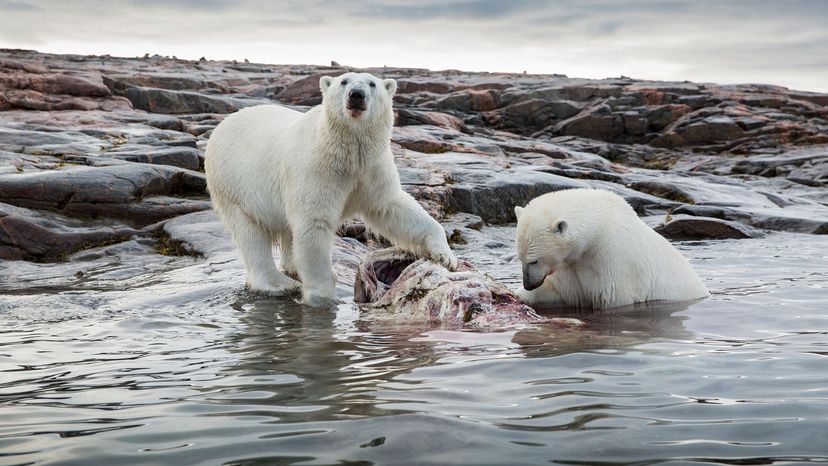Polar Bear Diet: Bears on the Hunt

In the Arctic, polar bears top the food chain. Both males and females hunt, and their favorite meal is seal, especially a ringed or bearded seal. When hunting's especially good, they'll just eat the seal's fat – which helps build up insulation – and leave the rest behind. The biggest bears can eat 100 pounds (45 kilograms) of blubber in one meal [source: Polar Bears International].
While polar bears prefer seals, they're opportunists. They'll eat anything from beluga whales to walruses [source: Arctic WWF]. The bears can find food on land if they have to, attacking reindeer and raiding birds' nests (bird eggs are a favorite snack), but they aren't well-adapted to hunting on land. Polar bears might even eat garbage generated by humans.
Advertisement
Instead, their strength is on the ice. Polar bears can't swim fast enough to catch a seal in the water and need an ice platform to use their full strength to grab one. But with global temperatures rising, Arctic ice floes melt earlier in the year than they used to, reducing the surface area on which bears can hunt. It also means that when polar bears wander onto land, they can end up stranded because the distance between land and the nearest ice sheet is too far to swim in one shot.
A hunt starts with a scent. Polar bears can smell seals more than half a mile (1 kilometer) away, often by the scent left on their breathing holes [source: Polar Bear International]. In the fall, when the ice is softer, seals cut holes in the ice so they can come up for air when they need to. Polar bears find such breathing holes and wait, sometimes for several days, until a seal comes up for a breath.
When a polar bear spots a seal coming up for air, it gets down on all fours, delicately putting each paw on the ice to keep silent. The bear then makes a shallow dive through the hole to grab the seal with its claws. Those sharp, 2-inch claws grip the seal extremely well. Still, seals sometimes get away. Polar bears have been known to express frustration when they lose their prey, pounding the ice or throwing blocks of it in a sort of tantrum. When the hunt is successful, a bear will share a kill with others as long as they beg properly: keeping low, circling the kill and occasionally nudging the hunter with their noses.
After eating, polar bears always clean up, which is why their fur stays so white. They need to stay dry and fluffy to maintain their body heat. They bathe in water during the summer and snow during the winter, using their tongues to clean their paws and cubs. After a good meal and a bath, they'll often take a nap, for much the same reason: Their survival depends on energy conservation. After any kind of exertion, they'll often lie down and go to sleep for an hour or so. Like humans, a polar bear's full "night's rest" lasts for about eight hours, although it's as likely to take place during the day as at night. The bears spend most of their time in 24-hour darkness and 24-hour light depending on the season, so time of day is largely irrelevant
Life on the ice is pretty routine for a polar bear, unless it's a pregnant one.